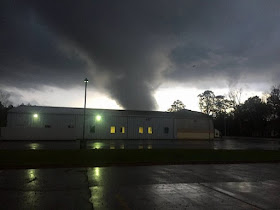Three people have died in an outbreak of tornadoes that swept across the US states of Alabama, Lousiana and Mississippi on Monday 16 December 2019. In Alabama two people were killed and several more people were injured when a tornado hit the town of Town Creek in Lawrence County' the two people who died are described as a couple, and one of the injured is reportedly their seven-year-old son, who is described as having critical injuries. Elsewhere in the state three more people were injured and two moble homes destroyed when a tornado hit the settlement of Salt Well in Marengo County. It Lousiana a 59-year-old woman, identified locally as Betty Patin, was killed when her mobile home was destroyed near Rosepine in Vernon Parish. In Mississippi seven people were injured when a home was destroyed in the town of Sumrall in Lamar County, and two people were injured by flying debris in Franklin County.
A tornado near Foxworth, in Marion County, Mississippi, at about 7.00 pm local time on Monday 16 December 2019. Jason Bedo/Twitter.
Tornadoes are formed by winds within large thunder storms called super cells. Supercells are large masses of warm water-laden air formed by hot weather over the sea, when they encounter winds at high altitudes the air within them begins to rotate. The air pressure will drop within these zones of rotation, causing the air within them so rise, sucking the air beneath them up into the storm, this creates a zone of rotating rising air that appears to extend downwards as it grows; when it hits the ground it is called a tornado.
Tornadoes can occur anywhere in the world, but are most common, and most severe, in the area of the American mid-west known as 'Tornado Ally', running from Texas to Minnisota, which is fuelled by moist air currents from over the warm enclosed waters of the Gulf of Mexico interacting with cool fast moving jet stream winds from the Rocky Mountains. Many climatologists are concerned that rising temperatures over the Gulf of Mexico will lead to more frequent and more severe tornado events.
Simplified diagram of the air currents that contribute to tornado formation in Tornado Alley. Dan Craggs/Wikimedia Commons/NOAA.
However tornadoes are typically summer events, with occrences as late as December being exceptionally rare. It is possible that this week's storms are linked to a developing El Niño syste,, which can bring warmer, wetter air to the southerb US than is typical for the time of year.
The
El Niño is the warm phase of a long-term climatic oscillation affecting
the southern Pacific, which can influence the climate around the world.
The onset of El Niño conditions is marked by a sharp rise in
temperature and pressure over the southern Indian Ocean, which then
moves eastward over the southern Pacific. This pulls rainfall with it,
leading to higher rainfall over the Pacific and lower rainfall over
South Asia. This reduced rainfall during the already hot and dry summer
leads to soaring temperatures in southern Asia, followed by a rise in
rainfall that often causes flooding in the Americas and sometimes
Africa. Worryingly climatic predictions for the next century suggest
that global warming could lead to more frequent and severe El Niño
conditions, extreme weather conditions a common occurrence.
Predicted changes to North American weather patterns during an El Niño event. NWS/NCEP Climate Prediction Center/NOAA.
See also...
Follow Sciency Thoughts on Facebook.









